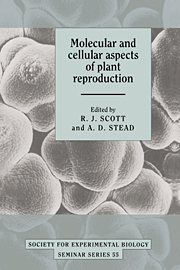Book contents
- Frontmatter
- Contents
- List of Contributors
- Introduction: ‘Where do we go from here?’
- Molecular control of floral organogenesis and plant reproduction in Petunia hybrida
- Control of floral morphogenesis in cauliflower (Brassica oleracea L. var. botrytis): the role of homeotic genes
- Isolation and properties of mutants of Arabidopsis thaliana with reduced sensitivity to short days
- Asexual mutants in Melandrium album (Silene alba): tools in cDNA cloning and analysis of an X/Y chromosome system in plants
- Pollen exine – the sporopollenin enigma and the physics of pattern
- The diversity and regulation of gene expression in the pathway of male gametophyte development
- Characterisation of Arabidopsis thaliana anther-specific gene which shares sequence similarity with β-1,3-glucanases
- Ovule cDNA clones of Petunia hybrida encoding proteins homologous to MAP and shaggy/zeste-white 3 protein kinases
- Towards the elucidation of the mechanisms of pollen tube inhibition during the self-incompatibility response in Papaver rhoeas
- Intracellular movement and pollen physiology: progress and prospects
- Organisation and functions of cell surface molecules on gametes of the brown algae Fucus
- Strategies of flower senescence – a review
- The physiology of petal senescence which is not initiated by ethylene
- Molecular biology of flower senescence in carnation
- Ethylene sensitivity and flower senescence
- Ethylene biosynthetic genes and inter-organ signalling during flower senescence
- Index
Intracellular movement and pollen physiology: progress and prospects
Published online by Cambridge University Press: 04 August 2010
- Frontmatter
- Contents
- List of Contributors
- Introduction: ‘Where do we go from here?’
- Molecular control of floral organogenesis and plant reproduction in Petunia hybrida
- Control of floral morphogenesis in cauliflower (Brassica oleracea L. var. botrytis): the role of homeotic genes
- Isolation and properties of mutants of Arabidopsis thaliana with reduced sensitivity to short days
- Asexual mutants in Melandrium album (Silene alba): tools in cDNA cloning and analysis of an X/Y chromosome system in plants
- Pollen exine – the sporopollenin enigma and the physics of pattern
- The diversity and regulation of gene expression in the pathway of male gametophyte development
- Characterisation of Arabidopsis thaliana anther-specific gene which shares sequence similarity with β-1,3-glucanases
- Ovule cDNA clones of Petunia hybrida encoding proteins homologous to MAP and shaggy/zeste-white 3 protein kinases
- Towards the elucidation of the mechanisms of pollen tube inhibition during the self-incompatibility response in Papaver rhoeas
- Intracellular movement and pollen physiology: progress and prospects
- Organisation and functions of cell surface molecules on gametes of the brown algae Fucus
- Strategies of flower senescence – a review
- The physiology of petal senescence which is not initiated by ethylene
- Molecular biology of flower senescence in carnation
- Ethylene sensitivity and flower senescence
- Ethylene biosynthetic genes and inter-organ signalling during flower senescence
- Index
Summary
Introduction
It is a truism of biology that most of the key processes typifying the living state in eukaryotic cells involve intracellular movement. Growth, morphogenesis, division, secretion, interaction with other cells, all require continuous physical redistribution of cell components, whether of organelles, membranes, vesicles, nuclei or chromosomes: in this respect the motility systems of the cell may be said to lie near to the heart of eukaryotic physiology. Our purpose in this outline review is to summarise some features of the life of the male gametophyte generation of the flowering plants as seen from this point of view.
Overt vectorial movement in the pollen tube itself is expressed in three main ways: in the circulation along its length of organelles and other cytoplasmic inclusions; in the net movement away from the parent pollen grain of the vegetative nucleus, the generative cell and the sperms formed from it; and in the transport and release through the plasmalemma of secretory vesicles concerned with the insertion of precursor materials into the growing wall and the release of enzymes into the environment. All of these processes are conducted within the confines of a single tip-growing, partly heterotrophic, cylindrical cell.
It is well established for both plant and animal cells that intracellular motility depends on interaction with cytoskeletal elements. Two systems are positively known from the pollen tube: one micro tubule based, and the other actin-fibril based.
- Type
- Chapter
- Information
- Molecular and Cellular Aspects of Plant Reproduction , pp. 191 - 202Publisher: Cambridge University PressPrint publication year: 1994
- 1
- Cited by

